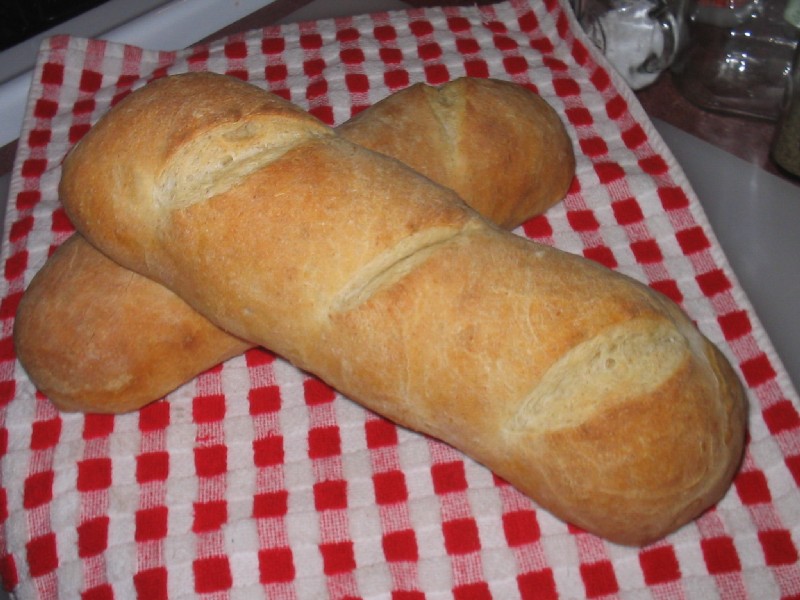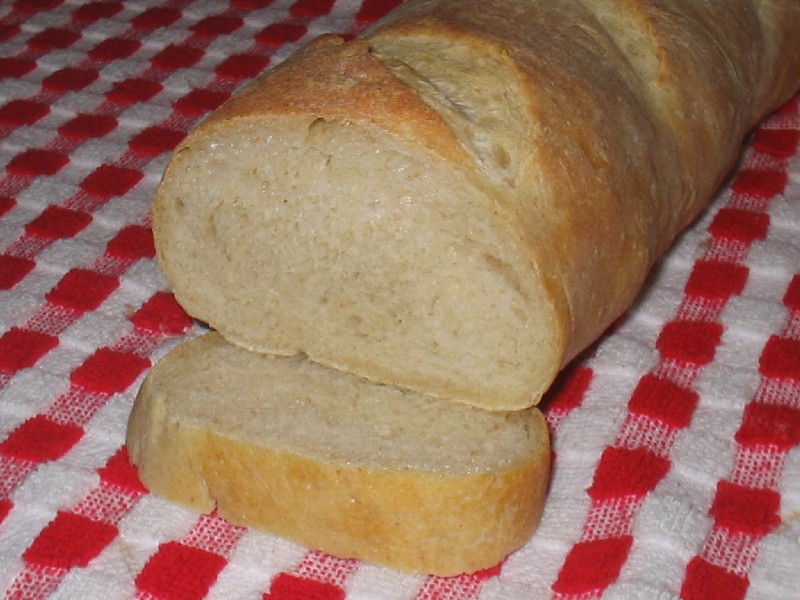
First San Francisco Style Sourdough Batard -- Tender and Delicious, but Soft Crust
This is my third sourdough bread-baking attempt. The first two loaves were baked as boules in a cast iron pot. The bread was delicious, and the crust was crunchy and chewy and had a bit of a shine to it. The scoring was a bit rough on the second loaf, but it was still a better loaf than I had expected.
This time, I chose to try batards instead of boules. I once again used Mike Avery's San Francisco Sourdough recipe from his "An Introduction to Sourdough Baking" booklet (free sample), and followed the "mild" formula with a starter at 100% hydration. Rather than kneading, I used the stretch-and fold technique at 20 minutes, and then 3 additional times at 45 minutes and then an unplanned fold-and-stretch after an additional hour-and-a-half. The dough was light as a feather when I shaped the batards. I proofed them on lightly oiled parchment paper, and was quite happy they held their shape as well as they did.
The loaves were baked on a stone that had been preheated to 475 degrees farenheit. After the loaves had risen completely, they were scored, spritzed with water, then transferred on the parchment paper to the stone. A cup of hot water was was poured into a pan that had also been preheated in the oven. The oven temperature was reduced to 450 degrees, and the loaves were baked for 15 minutes. At that time, they were nicely golden brown, and the crust sounded crisp and the loaves sounded hollow when thumped lightly with a wooden spoon. The internal temperature was 202, so I removed them to cooling racks.
The loaves didn't have the shiny, slightly blistery crust that I had hoped for. After cooling, it was soft to the touch. On slicing, the crumb was soft and delicate, and the flavor was wonderful. It was mildly sour, and had an unexpected smoothness to it.. While I missed the crispy-chewy crust of my iron pot breads, my wife said that it was the best loaf I have made so far. She prefers the softer crust.
Now that I can bake a loaf of bread that pleases my wife, maybe I could also learn to bake a batard with a crust that I also want. Any suggestions?




Success! You made your wife happy as well as yourself, and that's a great start.
The blistered crust you seek can be obtained through retarding the formed loaves overnight in the refrigerator.
David Snyder's blog has several recipes that are retarded overnight - you can pick and choose from any one of them.
I'll have to check out Mike's recipe as I've been looking for a slightly softer crust than what I'm accustomed to baking.
Thanks for the advice. I've also read that retarding in the refrigerator will give big holes in the loaf. The recipe of Mike's that I used was:
Interestingly enough, this is exactly the same recipe I used for my last loaf. It was baked in an iron pot and had an amazing crust. Here's a photo:
The difference had to be in in the baking method, but I haven't baked enough bread to know many variables.
Bob
If you are looking for a hard crust, preheat your oven to 500 degrees with a stone and a steaming pan, put the bread in the oven, pour in hot water into the steaming pan, and turn down to 450. Cook for the required time, then turn off the oven and let the bread sit on the stone for another 10 minutes to crisp up. That should make your bread a lot darker.
--Pamela
That makes sense, Pamela. How does it affect to crumb?
Bob
I don't think baking on a stone would effect the crumb on your bread much--you seem to have achieved a fairly open one with holes. If you want more holes and, perhaps, more structure/texture, to your crumb, try proofing it overnight in the refrigerator. If you do that, let it come to room temperature for an hour or so before you bake.
--Pamela
Pamela --
Sorry for any confusion, but the bread was baked on a stone with a water pan in the oven. I was questioning whether leaving it on the stone in the oven with the door open for another 10 minutes after baking would have any affect on the crumb, such as drying it out, etc.
I will try proofing it overnight in the refrigerator next time, as I would like to have just a bit more open crumb.
--Bob
Try proofing overnight in the fridge. That ought to improve your crumb. --Pamela
Leaving the bread on the stone with the oven turned off and the oven door shut--that's what I do--does dry out the bread a bit more, which is a good thing to my mind. The other thing that dries it out is *patience*. If you can't figure out a way to really let it cool on a baking rack for about 3 hours before slicing into it.
Sometimes I literally leave the house and run some errands because I have weak will-power when it comes to waiting. It is not so much that I want to eat it as see how it came out.
--Pamela
I just read your posting to my wife. She laughed and said "That's you". She's right, of course.
--Bob
It just so happens that I baked a SD loaf last night almost like this one. My problem was I took it out without checking internal temp. Since it was in the metel pan, the side and bottom were crusty but the top is not browned and inside is undercooked. Can I put it back in the oven to cook it again?
I also put a bowl of water in the oven when I preheated it and kept it in through the baking process, which made the crust soft and it looks just like this loaf.
I am certainly no expert on this, but I have undercooked a few pan breads in the past and have baked them again. I have had the best results by wrapping them in aluminum foil and baking at 350 for 15 to 20 minutes. Check the internal temperature by inserting a probe thermometer through the bottom of the loaf. Your crust, of course, will not be crisp any longer. The most important thing is to get the loaves up to a proper internal temperature so that they are edible. That's what bread is for isn't it - to eat and enjoy?
I have also had some luck freezing the foil-wrapped bread, then baking at at 350 farenheit for about an hour. Once again, take its temperature before removing from the oven.
If any of you experts out there have some better suggestions, please weigh in on this.
--Bob